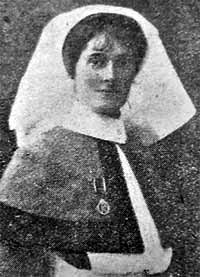Articles from the Thoroton Society Newsletter
The career of a remarkable nurse - Mary Ann Winfield Bannister

Mary Ann Winfield Bannister, second daughter of Samuel Winfield and Harriet Bannister, was born on 16th April 1879. Throughout her nursing career she was known as Marian and her birth year was given as 1880.
Marian was educated at High Pavement School. At 21, she was managing one of her father’s grocery shops on Colwick Street, Nottingham, assisted by her brother Samuel and sister Annie. By this time (1891), Samuel, her father, owned grocery shops on Glasshouse Street, Carlton Road, Sneinton Road and Lincoln Street, Basford. He had moved to a shop on Beeston High Road, the address (108/110) which Marian gave as home throughout her nursing career. Marian’s mother was managing this shop whilst her father was working for Thomas Humber, designing bicycle wheels with ball bearings. Her father was also leader of Beeston Urban District Council in 1908 and 1911.
In 1906 Marian’s elder sister Hannah died and shortly afterwards, her brother Samuel Winfield junior, came of age. Either of these events could have influenced Marian’s decision to train as a nurse in 1907.
Marian trained at Sheffield Royal Hospital from 1907-1910. She nursed at The Lawns Lunatic Asylum, Lincoln, from February 1910 to March 1912. At the end of March, she took five months out to complete midwifery training in Hastings where she gained her Central Midwives’ Board Certificate. Marian’s next job was at The Cameron Hospital, West Hartlepool for a year until September 1913. From there she went to Hull Royal Infirmary, where she worked until December 1914.
Marian joined the Queen Alexander’s Imperial Military Nursing Service Reserve and, equipped with a railway warrant and a cheque for twenty-four pounds, fifteen shillings, she journeyed to Boulogne en route to Number 5 General Hospital, Rouen. Marian’s report described a good surgical nurse who did sister’s duties for six months before being transferred. As a sister, she would have earned between £50 and £65 per annum plus accommodation and allowances. She was also a particularly good administrator, perhaps because of having managed a grocery shop?
Marian’s service record shows her working at five different casualty clearing stations, where sometimes her stay was only for a few days. Number 10 General Hospital and 7, 11 and 41 Stationary Hospitals are also listed. Two stays at the Nurses Hostel in Abbeville are also recorded. Marian was mentioned in Sir John French’s despatches in 1915 and she was awarded the Royal Red Cross 2nd class (a new medal) in the 1917 New Year’s Honours List. Marian was invited to Buckingham Palace by telegram in March 1917 to receive her medal and she also met Queen Alexandra at Marlborough House.
As Sister in Charge of 7 Casualty Clearing Station, Marian merited one of her five entries in Dame Maud McCarthy’s War Diaries. “Went to 7 CCS - saw the OC and the Sister i/c, Miss Bannister, who has absolutely transformed the unit, making it seem more like a General Hospital. Everything is in perfect order, the floors polished, the annexes clean, the orderlies working hard...”
Marian became Assistant Matron in 1917 at 41 Stationary Hospital and she was awarded the Royal Red Cross 1st class in the 1918 Honours List. She was made Acting Matron of Abancourt Stationary Hospital in February 1918. That summer Marian had a few days’ leave to nurse her mother, who died of pneumonia on 5th August. She was back on duty in France on 11th August 1918. After demobilisation, Marian arrived back in Folkestone on 29th November 1919, recommended to The Hospital for Diseases of the Throat, Golden Square in what is now Soho. She was matron there until 1922.
Marian had withdrawn the application she made to remain with QAIMNS reserve in 1919 but she did become a permanent reservist in June 1921. From then she had to report to QAIMNS annually so her employment is recorded.
From 1922 to 1932 Marian was Matron of Highbury Hospital, Birmingham, for the rehabilitation of wounded soldiers. State registration of nurses began in 1922 and Marian’s name is on the first register. In 1925, she accompanied a trip to the British Empire Exhibition where the wounded were transported around the pavilions in electric Railodok cars. In 1927 she met the king on his guided tour of Highbury Hospital.
A short period of unemployment followed this, but since Marian had inherited £5000 from her father’s estate in 1931, she was not in financial difficulty.
Her next job was Matron of the Nottinghamshire Convalescent Home, Seely House, at Seathorne, Skegness. This was the men’s home; the women’s home was Carey House. A contingent from Highbury Hospital visited her at Seathorne. She became involved in the local community and opened the Christmas Fair at St Mary’s, Winthorpe in 1936. The local newspaper report shows her sense of humour.
In 1938 Marian moved to be Matron of the Home and Colonial Nurses’ Co-operative in Hanover Square, London. She was concerned whether this counted as suitable service to remain with the QAIMNS reserve, but it did. Marian was there when World War 2 began. She was despatched to Number 6 Casualty Clearing Station at Catterick on 15th September 1939.
By now Marian was 60 and had reached the age limit for the QAIMNS reserve. Since her nursing record had 1880 as her birth year, they did not dismiss her until the summer of 1940. Marian did not want to give up and, after communication with Dame Katherine Jones, she was appointed Matron of Alton Emergency Hospital in Hampshire.
Marian remained on the State Register of Nurses until 1946. She died in The Hollies Nursing Home on Sherwood Rise, Nottingham, on 9th October 1970.
Jill Oakland
< Previous